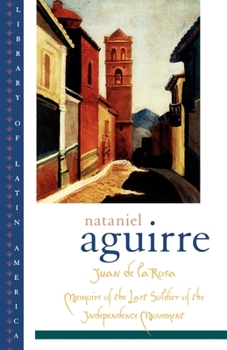Juan de la Rosa: Memoirs of the Last Soldier of the Independence Movement
Select Format
Select Condition 
Book Overview
Long considered a classic in Bolivia, Juan de la Rosa tells the story of a young boy's coming of age during the violent and tumultuous years of Bolivia's struggle for independence. Indeed, in this remarkable novel, Juan's search for his personal identity functions as an allegory of Bolivia's search for its identity as a nation. Set in the early 1800s, this remarkable novel is narrated by one of the last surviving Bolivian rebels, octogenarian Juan de la Rosa. Juan recreates his childhood in the rebellious town of Cochabamba, and with it a large cast of full bodied, Dickensian characters both heroic and malevolent. The larger cultural dislocations brought about by Bolivia's political upheaval are echoed in those experienced by Juan, whose mother's untimely death sets off a chain of unpredictable events that propel him into the fiery crucible of the South American Independence Movement. Outraged by Juan's outspokenness against Spanish rule and his awakening political consciousness, his loyalist guardians banish him to the countryside, where he witnesses firsthand the Spaniards' violent repression and rebels' valiant resistance that crystallize both his personal destiny and that of his country. In Sergio Gabriel Waisman's fluid translation, English readers have access to Juan de la Rosa for the very first time.
Format:Paperback
Language:English
ISBN:0195113284
ISBN13:9780195113280
Release Date:April 1999
Publisher:Oxford University Press
Length:368 Pages
Weight:0.97 lbs.
Dimensions:0.8" x 5.6" x 8.4"
Customer Reviews
2 ratings
Great historical novel
Published by Thriftbooks.com User , 26 years ago
Juan de la Rosa takes us to the 19th century in Latin America (Bolivia) and shows us how a people fought for its freedom. The novel mixes real facts with fiction; through its rich landscape and character descriptions, it transports us in time and space. We become sympathetic to little orphan Juan's suffering while growing up with unfriendly people, and his struggle to escape from opression. Through Juan's struggles we also see a whole people's fight for independence. There is a paralell maturing of Juan with the Bolivian independence movement. A high point in the novel is the battle between women and children on one side, armed with sticks and led by a blind woman, and the well-armed and cruel Spanish army on the other side. The novel is very effective in depicting the major players and crucial events in the independence movement. The development of Juan's particular story against the backdrop of the independence movement is really moving. While we become engaged in the historical developments we never lose sight of the personal struggles of the main character, including his search to find out his own identity. Higly recommended reading.
must read book
Published by Thriftbooks.com User , 27 years ago
It is one of the most compelling books for anyone interested in knowing about the independence movement in Latin America. This is a must read book in a great number of eduactional institutions in spanish-speaking America that will help anyone understand and appreciate hispanic culture.





